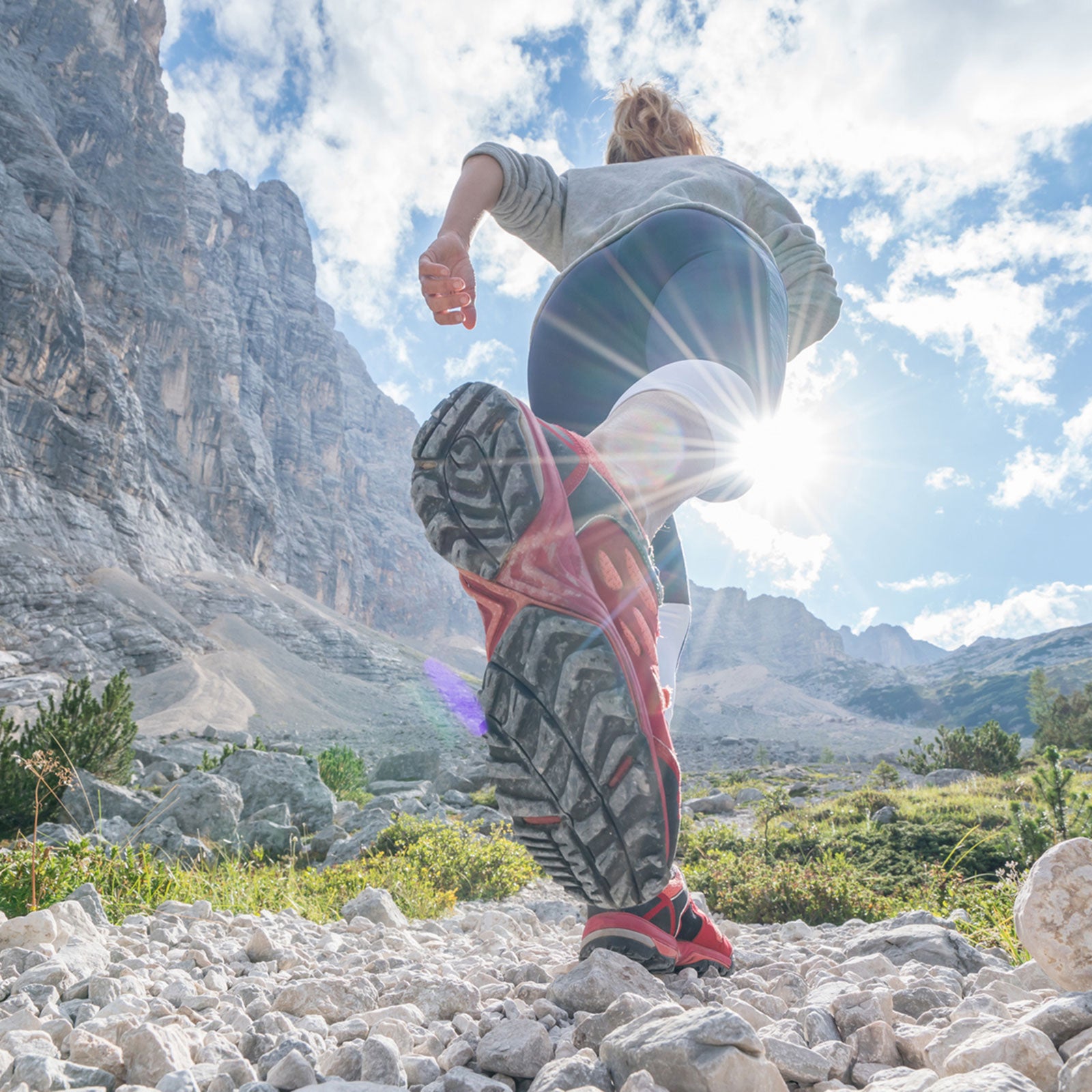Finding the right shoe can make a world of difference in your running experience and overall motivation. Good shoes will help prevent injury, open up new terrain, and just make running more fun. With the aid��of 30 testers, we evaluated close to��50 shoes, both road and trail, from racing flats to off-road monsters, in every condition we could throw at them (more on how we test shoes at the bottom of this article). We found some new favorites (the Hoka One One Evo��Mafate), great updates on old standbys (the Nike Air Zoom Pegasus 35), and some releases at fresh price points (the Salomon Ultra Pro). Here are seven��shoes we love and some pointers for choosing a��pair that’s right for you.
Our Favorite Road Shoe

Brooks Bedlam ($150)
With a two-part midsole that offers gentle, unobtrusive support, will appeal to a wide range of runners, from those who need pronation control to those who don’t. A layer of dense EVA foam, which Brooks calls guide rails, encircles the perimeter of your foot and nudges it gently into proper alignment. A complete layer of silver foam underneath the guide rails—Brooks’s DNA Amp material, a polyurethane-based cushioning—provides great energy return.
Meanwhile, the Bedlam’s knit upper and asymmetrical tongue wrap��around your��feet like a comfortable security blanket—snug��but not too tight. Testers with different shapes of feet all felt it was comfortable. The Bedlam is relatively heavy, at 11.2 ounces per shoe for the men’s version��and 9.9 ounces . It also has a moderate eight-millimeter drop from heel to toe.
Best Road Shoe for Speed

New Balance FuelCell Impulse ($120)
No matter your speed, you should have a shoe that makes you feel fast. The�� is that shoe. It’s light—8.1 ounces��for men and 6.7 ounces for women—but still has 23 millimeters of EVA foam under the heel and 17 millimeters under the forefoot.
The cushioning felt notably responsive toward the front of the shoe—there are two nitrogen-infused pods here—and provided a smooth and quick toe-off. But the beauty here is that this shoe isn’t a racing flat. It’ll work as a daily speed-oriented trainer for runners who like more cushioning day-to-day, making this a very appealing option for road races and workouts,��as well as for everyday training. Its moderate six-millimeter drop should also appeal to a wide range of runners.
����
Best Road Shoe for Speed with Cushioning
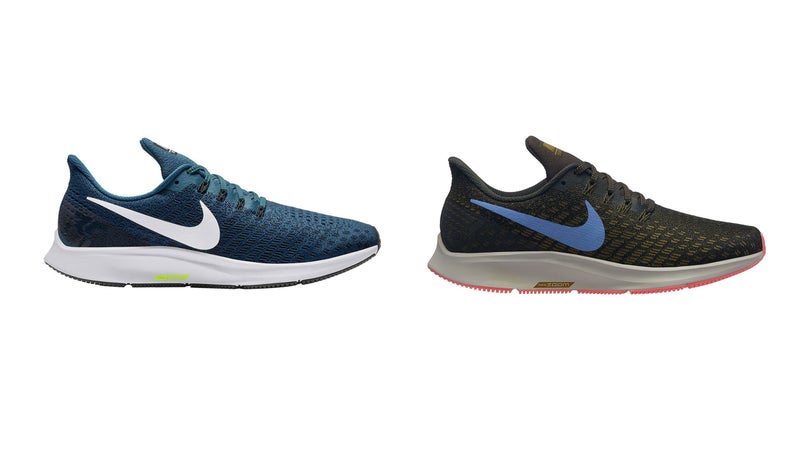
Nike Air Zoom Pegasus 35 ($120)
Nike has been making for nearly 35 years, and the newest version reminds us of why it has become the company’s all-time bestselling running shoe. Aside from cosmetic updates—the Pegasus 35 now takes cues from Nike’s world-famous Zoom Vaporfly 4%—the most significant change is in the midsole, which features an air pod running the length of the shoe. (The previous version had two separate air chambers.) The new single-chamber design is intended to carry the foot more fluidly from impact to toe-off. Our testers thought the Pegasus 35 felt firm, and one noted that it resembled “a racing flat or a light tempo shoe.” It’s not harsh, but it’s not as soft as the Brooks Bedlam.
Nike stuck with a tried-and-true breathable mesh upper, with a three-quarter bootie-style construction in the midsection. (For structure, Nike uses internal cables to distribute pressure evenly when you tighten the laces.) The men’s version is about ten��ounces per shoe, and is eight.
��
Best��Road Shoe for All-Weather Conditions
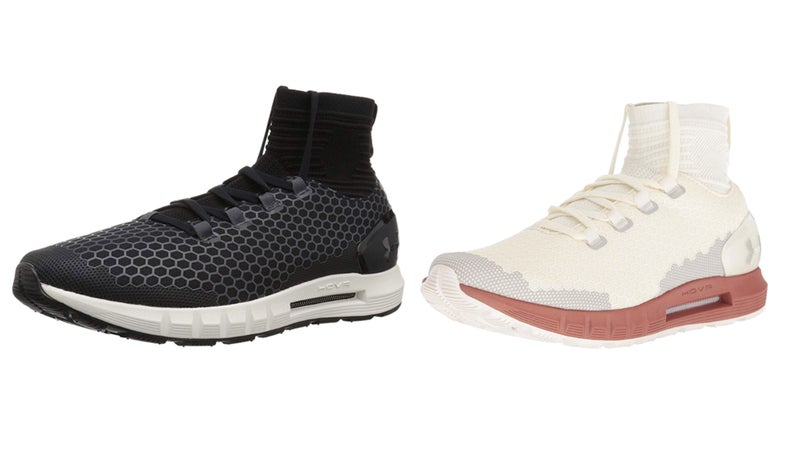
Under Armour Hovr��ColdGear Reactor MidConnected��($140)
Outfitted with a thick, water-resistant upper, and available in standard and midankle versions, is meant for cold-weather running. The midankle model has an elastic knit collar, which adds warmth and protection against the elements. (One tester noted that the extra material gives these shoes a tight fit, enough to consider buying a half size up.)
The midsole, made of extrasoft foam wrapped in mesh webbing, falls on the squishier end of the spectrum, yet not so much that it loses its responsive edge. And the outsole is made from a sticky Michelin rubber (yes, the auto tire). Some models also come with a small chip embedded in the midsole, which can connect to MapMyRun. Given all these features, the Hovr��ColdGear Reactor’s 10.9 ounces (8.8 ounces ) are reasonable.
Our Favorite Trail Shoe��
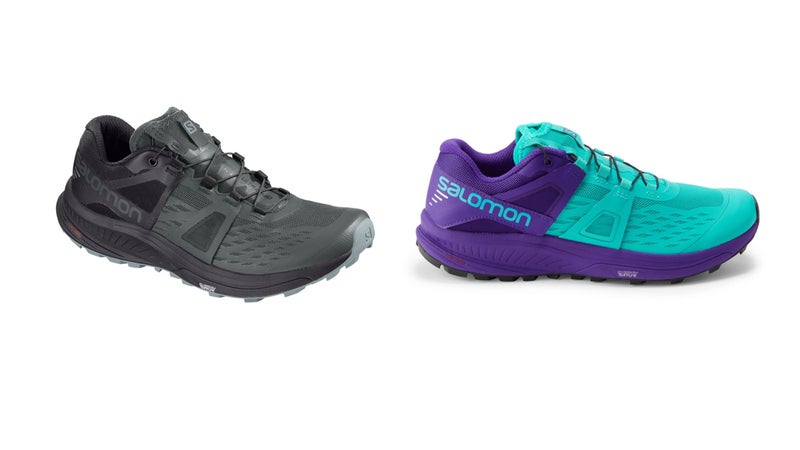
Salomon Ultra Pro ($150)
The�� is a new, more consumer-friendly (read: cheaper) version of one of Salomon’s all-time top-selling shoes, the S/Lab Sense Ultra. Underfoot, 24 millimeters of midsole (16 at the toe) offer��a mildly cushioned and responsive ride��without feeling too soft. In lieu of the S/Lab Sense Ultra’s rock plate, the company��opted for an all-new TPU-based foam insert to protect against small trail obstacles and deliver consistent cushioning whether at mile one or fifty. (TPU bounces back more readily than typical midsole foams.) We agree, the Ultra Pro did deliver on its promise of lasting cushioning��over long days, though one tester found that rock protection tapered off toward the forefoot.
Regardless, the Ultra Pro’s relatively light weight lends a nimble feel (the men’s size nine��is 10.3 ounces and size seven��is 8.8 ounces). One tester thought it “would be a great trail-racing shoe as well a daily trainer.” The four-millimeter outsole lugs are relatively tame��but handled any terrain—sand, rocks, mud, and water—like a champ.
The breathable mesh upper, though complex, is surprisingly versatile, with an��internal midfoot bootie that seals out trail debris. An external adjustable skeleton keeps the shoe secure while allowing you to loosen or tighten the fit at will. (The skeleton attaches to the laces. Loosening them relaxes the skeleton and creates more room around the sides of your feet.) The shoes worked for testers with narrow and wide feet alike, accommodated swelling, and still let us lock down the fit for technical descents.
��
Best Trail��Shoe for �����ԹϺ��� Runs
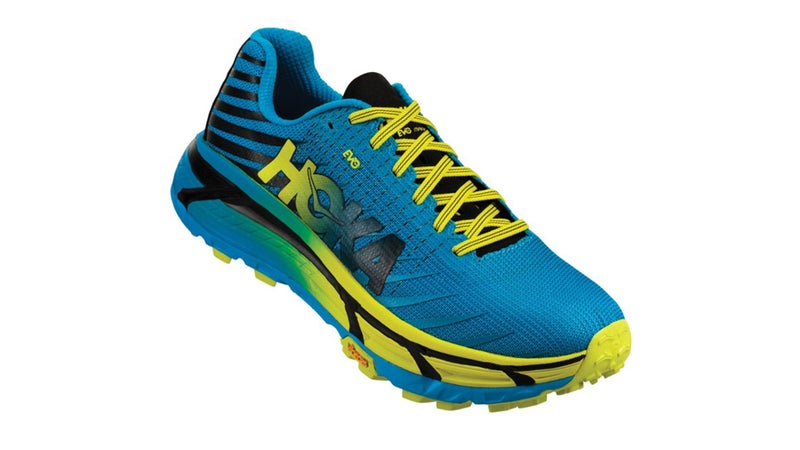
Hoka One One Evo��Mafate ($170)
Thanks to tiny, lightweight Kevlar wires woven into its mesh upper, offers something that’s been missing from Hokas for years: an agile ride. The shoe kept our feet in place on off-camber trails better than any other Hokas, which can feel unstable because they have so much cushioning underfoot. The Mafate still rides high, sitting at 34 millimeters under the heel and 30 millimeters under the forefoot, but the combination of softer and firmer foams felt more energetic than other Hokas with softer midsoles.
The Evo��Mafate’s five-millimeter lugs, made of Vibram Megagrip—sticky but lightweight—gave us traction on loose dirt and mud, and��in combination with a hydrophobic upper, lent confidence on sloppy, snow-covered roads. A fattened-up section of foam on the medial side of the midsole gives this shoe some stability to boot. The men’s version is 9.6 ounces and is 8.5 ounces.
��
Best Trail Shoe for All-Weather Conditions
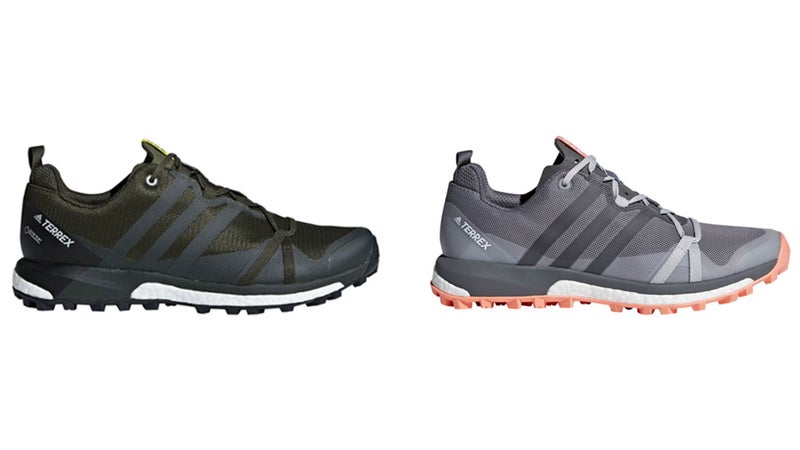
Adidas Terrex Agravic XT GTX ($170)
Layer one of the most responsive midsoles on the market (the Adidas Boost) on top of outsole rubber designed for tires on the world’s fastest sports cars, wrap the whole thing in Gore-Tex, and what do you get? One .
A low profile (15.5 millimeters in the heel and 9��millimeters in the forefoot) means feet stay close to the ground, allowing precise footwork through those rocky fall lines, when missteps sometimes mean rolled ankles in shoes with thicker midsoles. The aggressively patterned Continental rubber outsole sticks like glue on wet or dry terrain��but rides silky smooth, even on mellow ground. A bombproof upper��lined with Gore-Tex and thick, abrasion-resistant, welded materials means hiking boot–like durability and protection. Accordingly, these shoes are on the heavier side: 12.5 ounces in the men’s and 11.5 ounces in .
��
How We Pick the Best Running Shoes
Our reviewers have earned their chops in this��field.��Lisa Jhung��has been a runner for roughly 30 years and has reviewed shoes off and on for �����ԹϺ��� and other magazines for roughly 15 years. She has also worked at running magazines��and has written a book about trail running. Cory Smith has been testing running shoes for our��Buyer’s Guide since 2014. He was a nationally ranked runner at Villanova University��and now lives in Santa Barbara, California, where he owns an online running-coaching business called .
For this test, we researched new shoes across four categories—lightweight road, cushioned road, lightweight trail, and cushioned/protective trail—and had��testers focus on one category��for the best comparative results. We had close to 50 shoes across 18 brands, spread out among 38 testers who live and run everywhere from Montana to Alberta��and Kentucky to California. All of the women’s shoes were��tested by women. Each tester ran��at least three times in each shoe over the course of several months, at various speeds, in different conditions, and, for trail shoes, on a range of terrain from steep and rocky to mellow and buffed.��
What You Should Know Before Buying Running Shoes
Walk into any running store or visit any online site and what originally seemed like an easy task turns into a never-ending search full of confusing sales jargon. Subtle and often unseen differences in how shoes are constructed can change how comfortable they feel.
To add more complexity to the buying process, how a shoe fits and runs can vary greatly from brand to brand��and even model to model. Altra, a company��famous for its flared toe boxes, tends to accommodate runners with larger toes and wider feet. Asics, however, tends to fit on the narrower side of the spectrum. Our Gear of the Year shoe, the Brooks Bedlam, feels much softer underfoot than, say, the New Balance 860.
How to Choose Running Shoes
Intended Use (Road Versus��Trail)
Road running shoes are flexible in the forefoot, to flow��smoothly and allow a quick turnover, and they have lower-profile outsoles—no need for toothy lugs for traction. On mellow trails, road shoes can work just fine��and are usually lighter, more flexible, and more comfortable than burly trail models. But on rocky, muddy, snowy, or steep trails, you’ll want a specific shoe with aggressive lugs on the sole for better traction and more secure-fitting uppers to keep your feet stable on uneven terrain.
Fit
Ill-fitting running shoes will cause blisters, hot spots, and, in some cases, rolled ankles. There are a few elements to a good fit: length, width, and overall volume.
With regard to length, we recommend roughly a one-quarter-to-one-half-inch (a thumb’s width) gap between your longest toe and the front of the shoe to keep your toes from jamming forward during the toe-off phase and on downhills.
Width and overall volume can be a bit trickier. Excess pressure spots or parts of your feet bulging at��the sides are good clues that a shoe may be too tight. Alternately, if you find yourself having to cinch down hard on the laces to feel secure, the shoes are most likely too wide or deep. Some brands offer shoes in wide and narrow versions to accommodate runners outside the standard foot width.��
Pronation Control
When feet hit the ground, they either collapse inward, roll outward, or maintain a neutral orientation. Many brands design shoes for each of these three typical pronation patterns by varying the density in parts of their shoes’ midsoles to offer targeted support in the direction that you pronate and nudge your foot into a neutral position on impact.
There’s little scientific evidence to support this strategy, however, and it’s not clear that people who match shoes to their pronation patterns get fewer injuries. Our best advice is to simply choose the shoe that feels most comfortable.
Cushioning
Cushioning refers to the amount of foam under your foot and how firm or soft it is—whether the midsole holds its shape under pressure or compresses easily. There are benefits and drawbacks to both. Soft midsoles absorb impact, which is helpful for keeping joints happy over long distances. But they don’t feel springy. On the other hand, firm midsoles are peppy—the technical term is “responsive”—but don’t offer as much impact relief.
Ultimately, ideal cushioning is a matter of personal preference and running style. Those seeking an easy-going, comfortable ride should gravitate toward��softer,��cushioned midsoles, while performance-oriented runners should lean toward��a firmer, more responsive midsole.
To help conceptualize responsiveness as it relates to cushioning, think about the difference between dropping a lacrosse ball on concrete and dropping it on sand. Which surface would make the ball bounce back higher? Concrete would, because it’s harder than sand. Shoe midsoles work in a similar fashion.
Weight
Running shoes usually fall somewhere between 5��and 12 ounces per shoe for men and 4��and 10.5 ounces for women. Lighter shoes, unsurprisingly, are usually designed for racing. Numerous studies have confirmed that shaving weight results in quicker performance. found that a 3,000-meter race time increased by 0.78 percent��per 100 grams (roughly 3.5 ounces) of shoe weight. But��lighter shoes are less durable than those made for everyday training. Trail shoes, which often have tough outsole rubber compounds, rubber toe protectors, and rock plates, will usually be even heavier than road shoes.
Heel-Toe Drop
Most running shoes have a heel that’s slightly higher than the toe. A shoe’s “drop” is the difference between the two. In the past, running shoes had heel drops around 12 millimeters, under the assumption that most runners land on their heels and need more cushioning there to soften the blow. But that model has been challenged with the argument that a lower drop—one more in line with a bare foot—encourages more natural running. Companies have started selling shoes with lower drops, some even going to zero. There is no offset that works universally for every runner. Just be careful if you make a big change in either direction, and ease into running in the new shoe slowly. Jumping from, say, a 12-millimeter-drop shoe to a zero-drop shoe can put a lot of strain on lower leg muscles like the calves and Achilles tendon.
Weatherproofing
Winterized running shoes block moisture, often with a gaiter, a high-top cut, a weather-resistant fabric, or an internal waterproof layer. The downside: winterized shoes are often stiff, heavy, and not very breathable. In the last five years, winterized shoes have improved in all those areas, but the trade-offs still exist.
Price
High-quality running shoes retail for between $120 and $160. Specialized shoes come at a premium. (For example, expect to pay an additional $30 to $50 for winterized shoes.) On the other hand, racing flats will be cheaper, in the $80-to-$120 range.



